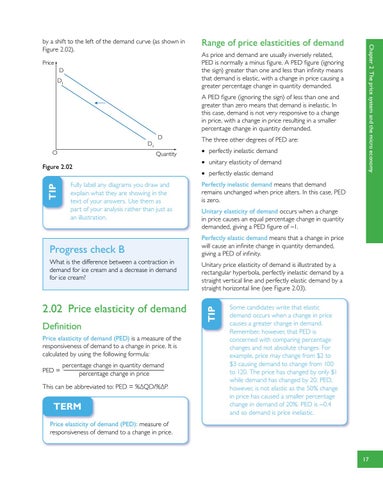Price D D1
Range of price elasticities of demand As price and demand are usually inversely related, PED is normally a minus figure. A PED figure (ignoring the sign) greater than one and less than infinity means that demand is elastic, with a change in price causing a greater percentage change in quantity demanded. A PED figure (ignoring the sign) of less than one and greater than zero means that demand is inelastic. In this case, demand is not very responsive to a change in price, with a change in price resulting in a smaller percentage change in quantity demanded.
O
D Quantity
TIP
Figure 2.02 Fully label any diagrams you draw and explain what they are showing in the text of your answers. Use them as part of your analysis rather than just as an illustration.
Progress check B What is the difference between a contraction in demand for ice cream and a decrease in demand for ice cream?
2.02 Price elasticity of demand Definition Price elasticity of demand (PED) is a measure of the responsiveness of demand to a change in price. It is calculated by using the following formula: percentage change in quantity demand PED = _______________________________ percentage change in price This can be abbreviated to: PED = %∆QD/%∆P.
TERM
The three other degrees of PED are: • perfectly inelastic demand • unitary elasticity of demand • perfectly elastic demand Perfectly inelastic demand means that demand remains unchanged when price alters. In this case, PED is zero. Unitary elasticity of demand occurs when a change in price causes an equal percentage change in quantity demanded, giving a PED figure of −1. Perfectly elastic demand means that a change in price will cause an infinite change in quantity demanded, giving a PED of infinity. Unitary price elasticity of demand is illustrated by a rectangular hyperbola, perfectly inelastic demand by a straight vertical line and perfectly elastic demand by a straight horizontal line (see Figure 2.03).
TIP
D1
Chapter 2 The price system and the micro economy
by a shift to the left of the demand curve (as shown in Figure 2.02).
Some candidates write that elastic demand occurs when a change in price causes a greater change in demand. Remember, however, that PED is concerned with comparing percentage changes and not absolute changes. For example, price may change from $2 to $3 causing demand to change from 100 to 120. The price has changed by only $1 while demand has changed by 20. PED, however, is not elastic as the 50% change in price has caused a smaller percentage change in demand of 20%. PED is −0.4 and so demand is price inelastic.
Price elasticity of demand (PED): measure of responsiveness of demand to a change in price.
17
